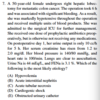DVS: Surgical Complications Flashcards

C. FFP
The ideal method for reversing an elevated INR in a pt receiving warfarin depends on the urgency with which reversal is needed. The pt presented has peritonitis and free air under the diaphragm. As such, urgent surgery is required, and therefore, urgent reversal of INR is necessitated.
FFP would provide the most immediate reversal.

- C, 3. D., 4. A
PE = uncompensated respiratory alkalosis
Pts with PE can have hypoxia, and the physiologic response to this is hyperventilation which results in a primary decrease in PCO2 (hypocapnia). Acute respiratory alkalosis causes light-headedness, confusion, peripheral paresthesia, cramps, syncope. Eventually pts will have a compensated respiratory alkalosis as the body’s excess HCO3 is buffered by extracellular hydrogen ion.
Combined respiratory alkalosis and metabolic acidosis = aspirin OD

C. ATN
The patient is oliguric and has evidence of AKI. The high urine Na (>40 mEq/L) and FENa >1% indicate an intrinsic (renal) etiology of AKI. The most commonc ause of renal AKI = ATN.

d. Echo with bubble study
This pt has symptoms and signs of postop stroke. Most postop strokes are ischemic (not hemorrhagic), and most ischemic strokes are embolic, arising from either the heart (afib) or from plaque at carotid bifurcation.
This patietn, however, has a DVT. The combination of an acute DVT and a stroke suggests paradoxical embolism, where a clot from the venous system enters the systemic as opposed to pulmonary circulation.
Most likely explanation is an intracardiac shunt should as PFO or ASD.
In this setting, a CT of the head would be the first study indicated to confirm whether the pt did have a stroke, and whether the stroke was ischemic or hemorrhagic –> but CT would not be helpful for determining the source of an embolic stroke.
CT of chest would be helpful if PE were suspected.

D. IV bolus of LR
The patient is in shock. Given the high CO, and low SVR, septic and anaphylactic shock are most likely. However, since the pt has not had any medications or unusual exposures and is breathing normally, it is most likely septic shock. Patients with difficult urinary catheterizations may have subsequent bacteremia which can result in septic shock. The first step in mgmt is aggressive IV fluid resuscitation with either NS or LR. Norepi = first-line vasopressor once fluids managed

B.
In a young patient presenting with recurrent epistaxis, isolated thrombocytopenia, and bleeding symptoms, an isolated acquired thrombocytopenia should be considered. ITP = autoantibodies against platelets and thus is considered a consumptive process. In a pt with platelet count < 30k and bleeding symptoms, corticosteroids***
If this doesn’t work - IVIG

